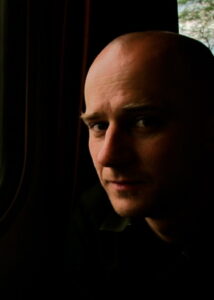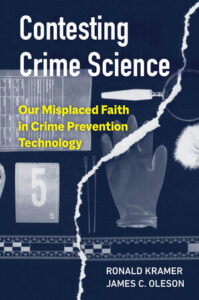
Ronald Kramer is Senior Lecturer in Criminology at the University of Auckland. His previous books include The Rise of Legal Graffiti Writing in New York and Beyond and Culture, Crime and Punishment.
In Contesting Crime Science, Ronald Kramer and James C. Oleson interrogate the promises of crime science and target our misplaced faith in technology as the solution to criminality. This book deconstructs crime science’s most prominent manifestations—biological, actuarial, security, and environmental sciences. Rather than holding the technological keys to crime’s resolution, crime sciences inscribe criminality on particular bodies and constitute a primary resource for the conceptualization of crime that many societies take for granted. Crime science may strive to reduce crime, but in doing so, it reproduces power asymmetries, creates profit motives, undermines important legal concepts, instantiates questionable practices, and forces open new vistas of deviant activity.
How did you become interested in this topic?
My interest in technological forms of crime control started when I was researching graffiti writing culture. One thing that struck me was how graffiti writers often found creative ways to resist efforts to control their art. When New York City invested heavily in removing ink and spray paint from trains, graffiti writers started scratching into surfaces and writing with “etch” – an acid substance that eats into glass. When the city put up sturdier fencing around train yards, graffiti writers switched from bolt-cutters to portable angle grinders.
This made me think about technological forms of control, and led to a series of questions: To what extent do crime prevention technologies fulfill the promises they make? What are their unintended consequences? What kinds of behaviors – especially those often presumed to be problematic or self-evidently criminal – inform crime control technology and how does crime control technology delimit our sense of what constitutes a problem? The book explores these kinds of questions.
In the book, you and co-author James Oleson lay out a convincing critique of crime science, which was initially conceived to reduce crime. What have been the unforeseen consequences of crime science?
We think there are many unforeseen – or perhaps “discernible but willingly ignored” – consequences of crime science. We try to think about various dimensions of the unforeseeable – how crime science is replete with implications for concepts and cultural frameworks, practices, and power relations. Crime science and its technologies presuppose and reinforce particular conceptualizations of “crime” while excluding other conceptual possibilities. Crime science works with a very conventional, hegemonic understanding of “crime” in that it assumes “street crime” and omits things like “state” or “corporate crime.” It rarely interrogates the definition of “crime.” It is difficult to reconcile crime prevention technologies with important legal concepts and principles. It is next to impossible, for example, to harmonize the logic and practice of prediction with due process.
At a broader, cultural level, crime science promotes the view that “if you are innocent, you have nothing to fear.” A better way to put this may be, “one need not fear the totalitarian state on the proviso they are ‘innocent.’” In this, crime science assumes it is the duty of individuals to show they are innocent, not the state’s job to prove guilt. It encourages conformity and docility, with CCTV, enhanced border controls, surveillance of communications, calls for universal DNA databases and the use of DNA dragnets. Relatedly, crime science endorses a cultural logic where almost every problem is understood as driven by some range of “defective individuals” and best addressed through a criminal justice lens.
There are many implications here for power relations. What is interesting is how crime science often leads both the “criminal” and those who control crime to courses of action that could be readily criminalized or seen as ethically problematic. Those deemed “criminal” often innovate rather than desist from criminalized behavior. Block the possibility of hijacking planes and terrorists find new targets; technology may mean that people do not carry cash anymore and so street robbery loses its cogency, but cyber-crime emerges.
More interesting to us, though, is how state practices become “immoral,” if not “criminal,” as a result of developments in crime science. Putting someone in prison because they may offend in the future would be considered criminal if it was done by anyone besides the state.
What was something surprising or unexpected that you learned over the course of your research?
I probably shouldn’t be surprised by this, but writing the book emphasized that much of criminology is complicit with crime science and state interests. “Mainstream criminologies” more or less endorse crime science or pose research questions that accord merit to its fundamental tenets. Given that we see crime science and power relations as so thoroughly fused – such that crime science amounts to an exercise of power – this means much criminology is complicit with the objectives and practices of power. The tendency to “side with power” is evident in criminology’s “founding figures” and then runs throughout much of its history. And this view of criminology is not an unusual one. Many have expressed similar sentiments or disappointment. There is a tendency to think of academia as a space for critical thinking, so it is always a bit depressing to be reminded that large areas of academia are not all that critical. We did discover many kindred spirits along the way, which was refreshing. But, it does seem to me that a major fault line divides criminology into its “conservative” and “critical” elements, and that most gravitate towards the former.
What is the main message you hope readers take away from the book?
I hope the book encourages a healthy scepticism toward technology and its promises. One of the core messages is that we need to escape technology fetishism if we are to address problematic practices. If we really want to address what typically passes for “terrorism,” for example, we need to shift our focus on geo-political tensions, foreign policies wherein more powerful nations exploit other regions. Likewise, there is no simple “tech-solution” to what are typically considered violent crimes.
The book also frames some important messages about criminology. The book shows how criminology need not reduce itself to “representational epistemology” and/or positivistic logic, that criminology is ill-served by doing so. In adopting a constructivist approach, I hope readers see the value of “observing how the observer observes,” to appropriate Luhmann. Instead of assuming that it is a matter of whether fidelity obtains between an “account of reality” and “reality” itself, I see it as more important to examine what our accounts of reality do. What do they assume, illuminate, or repress? What are their consequences?
